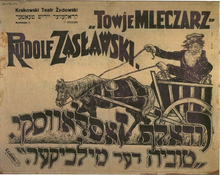History of the Jews in Krakow
The story of the Jews in Krakow is the description of Jewish life in Krakow , one of the most important cities in Poland .
Kingdom of Poland
In 1038 Krakow became the capital of the Polish state. In 1234, Bolesław the Pious issued extensive rights for Jews in Poland in the Kalisch Statute .
In 1348 Jews from Central Europe came to Krakow after pogroms . At that time, the Jewish quarter was in what is now the university quarter around ulica Świętej Anny (St. Anna Street). In 1495 the Jewish population was relocated to the nearby town of Kazimierz after a severe fire in the town .
In 1496 Jakob Polak came and founded the first yeshiva in Poland. The city became a spiritual center of Jewish culture. In 1497 the old synagogue was built.
In 1534 the Helicz brothers founded a Hebrew printing company, the first in Poland and Eastern Europe. Joseph ben Mordechai Gershon became head of a yeshiva. In 1550 Moses Isserles came to Cracow and became the main spiritual authority. He founded a yeshiva, became a dayan (judge) and representative in the Jewish council of the four countries in Poland. Mattitja ben Solomon Delacrut taught astronomy and Kabbalah. Students like Mordechai Jaffe studied in Kazimierz. The Remuh Synagogue was opened in 1553 .
In the centuries that followed, conditions for Jewish life deteriorated.
1772 to 1846
In 1795 Krakow came under the Habsburg Monarchy , in 1815 it became the Republic of Krakow . In 1822 the city walls in Kazimierz were torn down. Jews were now allowed to settle in all of Krakow, but Kazimierz remained the Jewish center.
In the uprising of 1846 , many Jews, such as Chief Rabbi Dow Ber Meisels, supported the Polish aspirations for independence.
Austrian Empire
In 1846 Krakow became part of the Austrian Empire . Jews had extensive rights. Meisels became a member of the city council and representative of Krakow in the Imperial Council of Austria .
In 1857 37% of Kraków's population was Jewish. Most of the population lived in simple circumstances and earned their living with low jobs. Krakow became a center of the Jewish Bundestag labor movement .
In 1905, Jews from Russia came to Krakow after pogroms. The city became a center of the Zionist movement .
The Makkabi Kraków sports club was founded in 1909, and Jutrzenka Kraków in 1910 .
Second Polish Republic
In 1918 Krakow became part of the new Polish Republic . The Jewish population was formally equal. Mordechaj Gebirtig described in his songs precisely and lovingly the life of the ordinary Jewish population in Krakow.
Conditions deteriorated in the late 1920s. Kazimierz was the district of the poor and orthodox Jewish population. The wealthier lived in Podgórze or other parts of the city.
In 1939 there were 130 synagogues and prayer houses in Kraków.
German occupation
In 1941 the Krakow ghetto was established in the Podgórze district . Most of the residents were killed by 1944.
People's Republic of Poland and Third Republic
On August 11, 1945 there were serious riots against Jews in Krakow.
Today the Tempel Synagogue and the Remuh Synagogue are in use, there is a community center , the Judaica Foundation - Center for Jewish Culture , a Jewish museum and a Jewish cultural festival .
Population development
| Number of Jews in Krakow | |||||||
| year | Total population | Jews | proportion of | ||||
|---|---|---|---|---|---|---|---|
| 1857 | 34,200 | 12,937 | 37.8% | ||||
| 1869 | 49,800 | 17,670 | 35.5% | ||||
| 1880 | 66,300 | 20,269 | 30.6% | ||||
| 1890 | 72,400 | 20,939 | 28.0% | ||||
| 1900 | 91,000 | 25,670 | 28.1% | ||||
| 1910 | 152,000 | 32,321 | 21.3% | ||||
Synagogues
- Old synagogue
- Remuh Synagogue (1553/56)
- High Synagogue (1563)
- Kupa Synagogue (1643)
- Isaac Synagogue (1644)
- Popper Synagogue (1620)
- Temple Synagogue (1862)
Mikvahs
- Large Mikvah (1567)
literature
- Jehuda L. Stein: Jews in Krakow. A historical overview 1173–1939. Hartung-Gorre, Konstanz 1997, ISBN 3-89649-201-2 .
- Heinz-Dietrich Löwe : The Jews in Krakau-Kazimierz until the middle of the 17th century. In: Michael Graetz (Ed.): Creative moments of European Judaism in the early modern period. Winter, Heidelberg 2000, ISBN 3-8253-1053-1 , pp. 271-320.
Web links
- Heidemarie Petersen: Kraków: Kraków before 1795. In: YIVO Encyclopedia of Jews in Eastern Europe. October 27, 2010, accessed August 17, 2015 .
- Sean Martin: Kraków: Kraków after 1795. In: YIVO Encyclopedia of Jews in Eastern Europe. August 19, 2010, accessed August 17, 2015 .
Individual evidence
- ^ Martin Rothkegel: A Jewish-German manuscript by the printer and convert Johannes Helicz, Breslau 1537. In: Communio Viatorum. 44 (2002) 1, pp. 44–50 ( PDF ( Memento of the original of February 13, 2012 in the Internet Archive ) Info: The archive link has been inserted automatically and has not yet been checked. Please check the original and archive link according to the instructions and then remove them Note. )
- ^ Results of the censuses of the KK Statistische Central -ommission u. a., in: Anson Rabinbach : The Migration of Galician Jews to Vienna. Austrian History Yearbook, Volume XI, Berghahn Books / Rice University Press, Houston 1975, pp. 46/47 (Table III)




